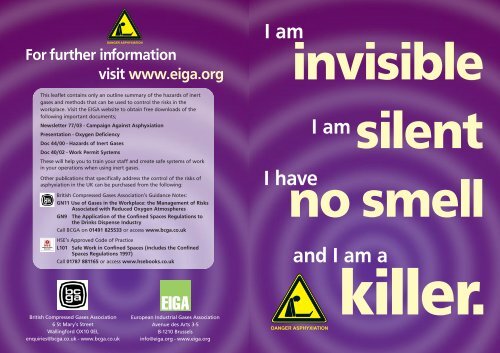33555 Dangers of Asphyx. EIGA - British Compressed Gases ...
33555 Dangers of Asphyx. EIGA - British Compressed Gases ...
33555 Dangers of Asphyx. EIGA - British Compressed Gases ...
You also want an ePaper? Increase the reach of your titles
YUMPU automatically turns print PDFs into web optimized ePapers that Google loves.
DANGER ASPHYXIATION<br />
For further information<br />
visit www.eiga.org<br />
This leaflet contains only an outline summary <strong>of</strong> the hazards <strong>of</strong> inert<br />
gases and methods that can be used to control the risks in the<br />
workplace. Visit the <strong>EIGA</strong> website to obtain free downloads <strong>of</strong> the<br />
following important documents;<br />
Newsletter 77/03 - Campaign Against <strong>Asphyx</strong>iation<br />
Presentation - Oxygen Deficiency<br />
Doc 44/00 - Hazards <strong>of</strong> Inert <strong>Gases</strong><br />
Doc 40/02 - Work Permit Systems<br />
These will help you to train your staff and create safe systems <strong>of</strong> work<br />
in your operations when using inert gases.<br />
Other publications that specifically address the control <strong>of</strong> the risks <strong>of</strong><br />
asphyxiation in the UK can be purchased from the following:<br />
<strong>British</strong> <strong>Compressed</strong> <strong>Gases</strong> Association’s Guidance Notes:<br />
GN11 Use <strong>of</strong> <strong>Gases</strong> in the Workplace: the Management <strong>of</strong> Risks<br />
Associated with Reduced Oxygen Atmospheres<br />
GN9 The Application <strong>of</strong> the Confined Spaces Regulations to<br />
the Drinks Dispense Industry<br />
Call BCGA on 01491 825533 or access www.bcga.co.uk<br />
HSE’s Approved Code <strong>of</strong> Practice<br />
L101 Safe Work in Confined Spaces (includes the Confined<br />
Spaces Regulations 1997)<br />
Call 01787 881165 or access www.hsebooks.co.uk<br />
<strong>British</strong> <strong>Compressed</strong> <strong>Gases</strong> Association<br />
6 St Mary’s Street<br />
Wallingford OX10 0EL<br />
enquiries@bcga.co.uk - www.bcga.co.uk<br />
European Industrial <strong>Gases</strong> Association<br />
Avenue des Arts 3-5<br />
B-1210 Brussels<br />
info@eiga.org - www.eiga.org<br />
I am<br />
I have<br />
invisible<br />
I am<br />
silent<br />
no smell<br />
and I am a<br />
DANGER ASPHYXIATION<br />
killer.
<strong>Asphyx</strong>iation - the hidden killer.<br />
Common risks & hazards -<br />
Be aware and be safe<br />
Each year several deaths involving asphyxiation by industrial gases are reported<br />
to <strong>EIGA</strong>. The majority <strong>of</strong> these fatalities are caused by people entering a<br />
confined space where there is an oxygen deficient atmosphere caused by the<br />
presence <strong>of</strong> inert gases.<br />
Cause & Effect<br />
Rather than being due to unforeseen circumstances, most cases <strong>of</strong> death by<br />
industrial gas asphyxiation are the result <strong>of</strong> a failure <strong>of</strong> health and safety<br />
procedures. Most failures follow a familiar pattern and reveal:<br />
• Incorrectly applied working procedures<br />
• Insufficient training and supervision<br />
• Inadequate management controls<br />
Know the Hazard<br />
• Inert gases give no warning - the human body does not detect oxygen<br />
deficiency<br />
• Oxygen is life - Without enough oxygen you cannot live<br />
• Normally, air contains 21% oxygen, but becomes hazardous when<br />
the concentration falls to 18%<br />
• Below 10% oxygen, fainting occurs without warning, brain damage<br />
and then death occur in a few minutes unless resuscitation is carried<br />
out immediately<br />
• Just two breaths <strong>of</strong> nitrogen or other inert gas causes immediate loss <strong>of</strong><br />
consciousness and death follows rapidly<br />
DANGER ASPHYXIATION<br />
Observe the regulations -<br />
Know your responsibilities<br />
Confined Spaces<br />
Many confined spaces where asphyxiation accidents may occur, such as closed tanks,<br />
vessels and sewers, are generally easy to identify. Others are less obvious, but equally<br />
dangerous; for example open topped tanks, vats, closed and unventilated rooms and<br />
cellars.<br />
Accidents due to oxygen deficient atmospheres have been caused by:<br />
• Entry into confined spaces which had not been purged into a breathable atmosphere<br />
• Process lines which had not been adequately isolated<br />
• Leaks from cylinders or hoses<br />
• Spillages from dewars<br />
• Process vents which had not been routed to a safe area<br />
Before entering a confined space, a safe system <strong>of</strong> work must be developed that has<br />
identified all the hazards and ensured that the necessary controls are in place to ensure<br />
workers are not exposed to oxygen deficient atmospheres<br />
A safe system <strong>of</strong> work would typically be in the form <strong>of</strong> a comprehensive “permit to<br />
work” and would include requirements for:<br />
• Risk assessments & method statements<br />
• Physical isolations<br />
• Safe access & egress<br />
• Gas analysis & personal monitors<br />
• Standby man and rescue equipment<br />
• Respiratory protective equipment<br />
Other activities which carry a risk <strong>of</strong> asphyxiation include:<br />
• Filling open dewars/Transport <strong>of</strong> dewars in closed vehicles<br />
• Incorrect use <strong>of</strong> breathing gas container adaptors<br />
• Connecting the wrong gases to breathing systems<br />
• Incorrect operation <strong>of</strong> food freezing tunnels<br />
• Using gases in unventilated cellars and basements<br />
• Filling and emptying solid CO 2 containers<br />
• Attempting rescue without first considering asphyxiation risks


